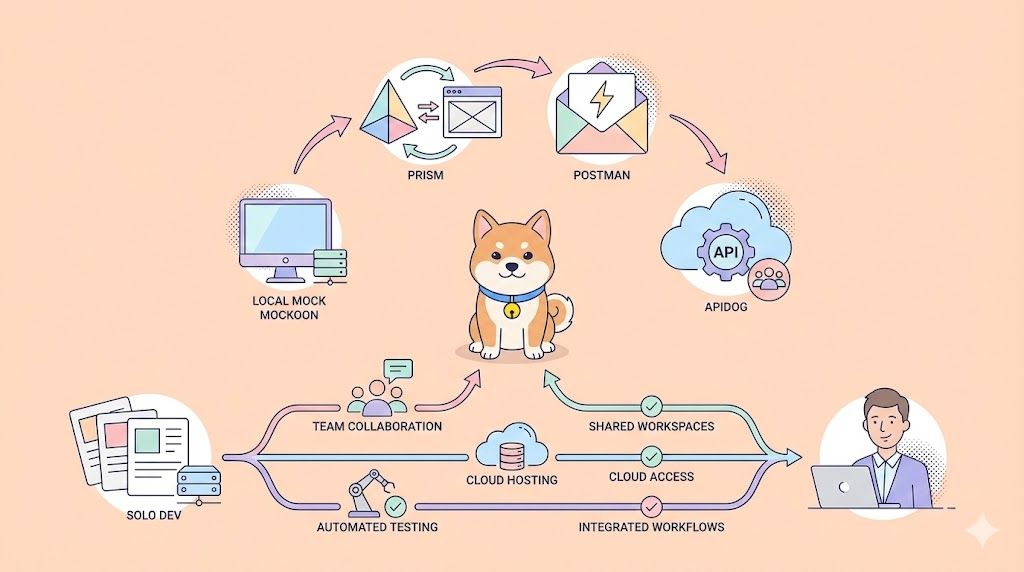In the digital security domain, OAuth and JWT (JSON Web Tokens) are integral components, yet they cater to different aspects of web security and identity management. Understanding the distinctions between OAuth and JWT is crucial for developers and organizations to build secure and efficient web applications. Let's delve deeper into each of these technologies to unravel their intricacies and explore their key differences.
Click the Download button below to enjoy seamless OAuth authentication with Apidog.
What is OAuth?
OAuth is an authorization framework that enables third-party applications to obtain limited access to a user's data hosted on another service, without requiring the user to expose their login credentials. It's widely used for permission-based access, allowing users to control which parts of their data can be accessed by third-party applications.
OAuth Versions
There are two main versions of OAuth: OAuth 1.0 and OAuth 2.0. They both serve the purpose of secure authorization for APIs, but there are significant differences between them:
OAuth 1.0:
- Developed in 2006 and published in 2007.
- Relies on signatures and authorization headers for secure communication.
- Considered more complex and verbose to implement.
- Deprecated due to security vulnerabilities and limitations.
OAuth 2.0:
- Introduced in 2012.
- Utilizes tokens for authorization, offering better security and flexibility.
- Simpler and more widely adopted than OAuth 1.0.
- The current industry standard for API authorization.
// JavaScript code to redirect to OAuth Provider (e.g., Google)
function redirectToOAuthProvider() {
const oauthUrl = 'https://accounts.google.com/o/oauth2/v2/auth?response_type=code&client_id=YOUR_CLIENT_ID&redirect_uri=YOUR_REDIRECT_URI&scope=profile email';
window.location.href = oauthUrl;
}
How OAuth Works
- User Authorization: The user authorizes a third-party application to access their data on a service (like a social media platform).
- Obtaining Access Token: The third-party application receives an access token from the service.
- Accessing Data: The application uses this token to access the user's data within the scope of permission granted.

Key Features of OAuth
- Token-Based: It uses access tokens rather than user credentials for authorization.
- Scope of Access: OAuth defines the extent of access, limiting third-party applications to specific data and actions.
- Security: Reduces the risk of user credentials being exposed.
What is JWT?
JWT, short for JSON Web Tokens, is a compact and self-contained way for securely transmitting information between parties as a JSON object. This information can be verified and trusted because it is digitally signed.
const jwt = require('jsonwebtoken');
// User information payload
const userPayload = { id: 'user123', name: 'John Doe' };
// Secret key for signing the JWT
const secretKey = 'YOUR_SECRET_KEY';
// Generating a JWT
const token = jwt.sign(userPayload, secretKey, { expiresIn: '2h' });
JWT Structure
- Header: Contains token type and signing algorithm.
- Payload: Holds the claims, which are statements about an entity (user) and additional data.
- Signature: Verifies that the sender of the JWT is who it says it is and ensures that the message wasn't changed along the way.

Key Features of JWT
- Compactness: Being URL-safe, JWT is easily transmitted through an HTTP header.
- Self-Contained: The payload contains all the required information about the user, avoiding the need to query the database more than once.
- Versatility: Widely used in web applications for authentication and information exchange.
Key Differences: OAuth vs JWT
Purpose and Use
- OAuth is primarily concerned with authorization, acting as an intermediary on behalf of the end user, and granting third-party access to server resources.
- JWT is used for securely transmitting information between parties. It's often used for authentication, as the server can verify the user's identity based on the token.
Implementation and Flow
- OAuth involves a more complex flow, requiring interaction between four parties – the resource owner, the client, the authorization server, and the resource server.
- JWT is simpler in terms of implementation. It’s a token that can be directly passed to authenticate and authorize users or systems.
Security Dynamics
- OAuth relies on the issuing authority to manage tokens and validate user permissions.
- JWT ensures security via its structure, with the signature part ensuring the token's integrity.
Flexibility and Scope
- OAuth provides different grant types for different scenarios (like Authorization Codes for web applications and Implicit for mobile apps).
- JWT can be used in various scenarios beyond OAuth, such as between two services or for backend authentication.
OAuth vs JWT: Comparison Table
Aspect |
OAuth |
JWT |
|---|---|---|
| Type | Authorization framework | Token format |
| Primary Use | Access delegation for third-party apps | Secure information exchange and authentication |
| Operation | Grants access tokens for API access | Encodes claims such as user identity |
| Security | Dependent on the authorization server | Encoded and digitally signed for integrity |
| Flexibility | Various authorization flows for different use cases | Used in multiple scenarios, not limited to authorization |
| Data Storage | Tokens do not contain significant user data | Self-contained with user data |
Why Choose Apidog to Authenticate OAuth?
Apidog stands out as a robust tool for OAuth authentication. This platform simplifies the OAuth setup, enhances testing and debugging, and offers comprehensive support for OAuth standards. Here’s a brief overview of Apidog’s key features:


User-Friendly Interface
- Simplified OAuth Setup: Apidog's interface is designed to be intuitive, making the process of setting up OAuth straightforward, even for those who are not experts in OAuth protocols.
- Guided Configuration: The platform guides users through the OAuth configuration process, reducing the likelihood of errors and saving time.
Integrated Testing and Debugging
- Direct API Testing: With Apidog, you can test OAuth-secured APIs directly within the platform, eliminating the need for external tools or writing extensive test code.
- Debugging Support: If issues arise during the OAuth process, Apidog provides helpful debugging tools to identify and resolve problems efficiently.
Comprehensive OAuth Standards Support
- Versatile Compatibility: Apidog supports a wide range of OAuth standards, making it versatile for different types of API integrations.
- Flexibility with Grant Types: The platform accommodates various OAuth grant types, catering to different application requirements and scenarios.
Enhanced Security and Reliability
- Secure Data Handling: Apidog emphasizes the secure management of OAuth tokens and sensitive data, which is crucial for maintaining data privacy and security.
- Trusted Platform: As a reliable tool in the API development community, Apidog offers a dependable solution for OAuth authentication.
Collaboration and Documentation Features
- Teamwork Facilitation: The platform’s collaborative features are beneficial for teams working together on API projects, allowing seamless sharing and testing of OAuth configurations.
- History and Documentation: Apidog provides documentation capabilities and history tracking, which are valuable for ongoing maintenance and auditing of OAuth setups.
Conclusion
In the context of web security, OAuth and JWT serve distinct yet complementary roles. OAuth is the go-to framework for managing user permissions and granting access to third-party applications without exposing user credentials. Meanwhile, JWT stands out for its ability to securely transmit user data and authenticate identities. Recognizing the differences and applications of OAuth and JWT is imperative for developers and organizations to harness these technologies effectively, ensuring secure and seamless web experiences.



